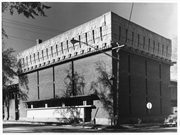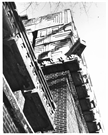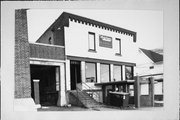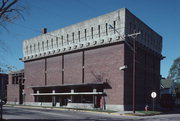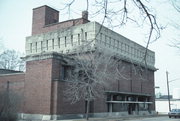177 E. Haseltine St., 300 S. Church St
| Historic Name: | A. D. German Wholesale Company and Warehouse, Adtl Documentation |
|---|---|
| Reference Number: | 74000122 |
| Location (Address): | 177 E. Haseltine St., 300 S. Church St |
|---|---|
| County: | Richland |
| City/Village: | Richland Center |
| Township: |
| A.D. German Wholesale Company and Warehouse 177 East Haseltine Street & 300 South Church Street, Richland Center, Richland County Architect: Frank Lloyd Wright Date of Construction: 1912 & 1921 Albert Delvino German was a significant member of the merchant class in the city of Richland Center; first as a hotel owner, then developing a dray line which evolved into a wholesale enterprise. His business, the A.D. German Wholesale Grocery Company, was a part of Richland Center’s booming economy in the early years of the twentieth century through the World War I. The Richland Democrat reported, June 15, 1908, that Mr. German started a new dray and transfer line in the city. This business began as one of several of this type located in the city. Business was profitable. In four years, German built his first warehouse located at 177 East Haseltine Street. Upon moving into the new building, his business greatly accelerated and three years later he needed even more space. By this time, wholesale business was transitioning from horse-drawn to vehicular delivery. German’s Wholesale Grocery Company grew to be the second largest wholesaler in the city, serving southwestern Wisconsin. For his next warehouse, German tapped a customer, local architect Frank Lloyd Wright. Wright designed an innovative, four-story concept in 1915. Construction began in 1917 and continued until 1921. The A.D. German Warehouse by Frank Lloyd Wright has been listed on the National Register of Historic Places. Frank Lloyd Wright is generally considered to be the most important architect that the United States has yet produced. The Wright-designed A.D. German Warehouse is widely acknowledged by scholars as Frank Lloyd Wright’s first expression of pre-Columbian motifs combined with archetypal forms from the Froebel blocks of his childhood. It prefigures the continued expression of these forms in such residences as the Barnsdall House of 1920 and the Ennis House of 1923, both in Los Angeles, California. Before 1915, Wright’s interest in architecture of Mesoamerica had manifested itself only in ornamental details such as in Midway Gardens of 1914 in Chicago, Illinois. The massive cornice frieze that wraps the building is an excellent example of Wright’s early innovation in exposed, reinforced, cast-in-place concrete.
This property is private. Please respect the privacy of the owners. |
| Period of Significance: | 1912-1936 |
|---|---|
| Period of Significance: | 1921 |
| Area of Significance: | Architecture |
| Area of Significance: | Commerce |
| Applicable Criteria: | Architecture/Engineering |
| Applicable Criteria: | Event |
| Historic Use: | Commerce/Trade: Warehouse |
| Architectural Style: | Modern Movement |
| Architectural Style: | Other |
| Architectural Style: | Late 19th And Early 20th Century American Movements |
| Resource Type: | Building |
| Architect: | Frank LLoyd Wright |
| Historic Status: | Listed in the National Register |
|---|---|
| Historic Status: | Listed in the State Register |
| Historic Status: | Additional Documentation |
| Historic Status: | Additional Documentation, State Register |
| National Register Listing Date: | 12/31/1974 |
| State Register Listing Date: | 01/01/1989 |
| Number of Contributing Buildings: | 2 |
|---|---|
| Number of Contributing Sites: | 0 |
| Number of Contributing Structures: | 0 |
| Number of Contributing Objects: | 0 |
| Number of Non-Contributing Buildings: | 0 |
| Number of Non-Contributing Sites: | 0 |
| Number of Non-Contributing Structures: | 0 |
| Number of Non-Contributing Objects: | 0 |
| National Register and State Register of Historic Places, State Historic Preservation Office, Wisconsin Historical Society, Madison, Wisconsin |

